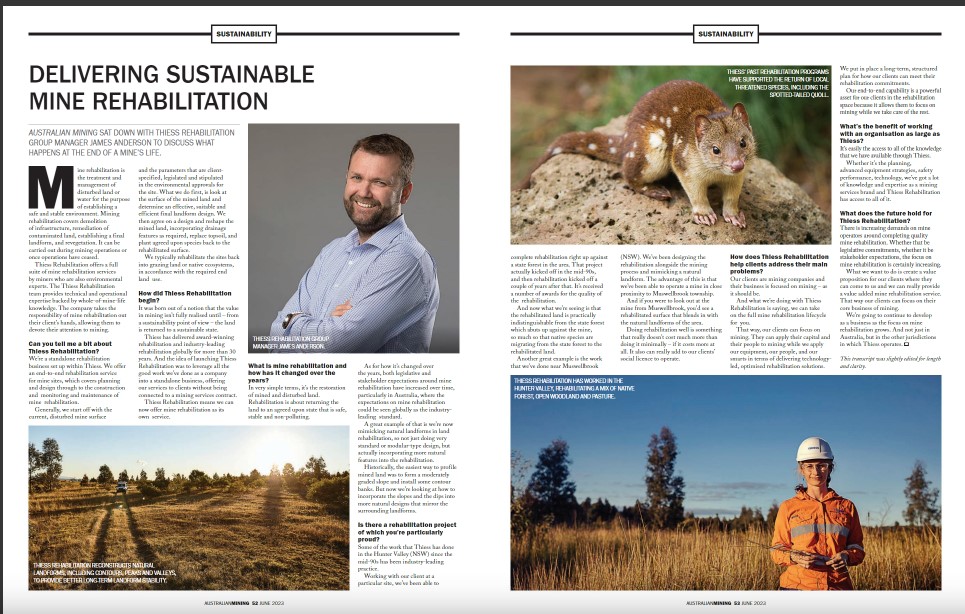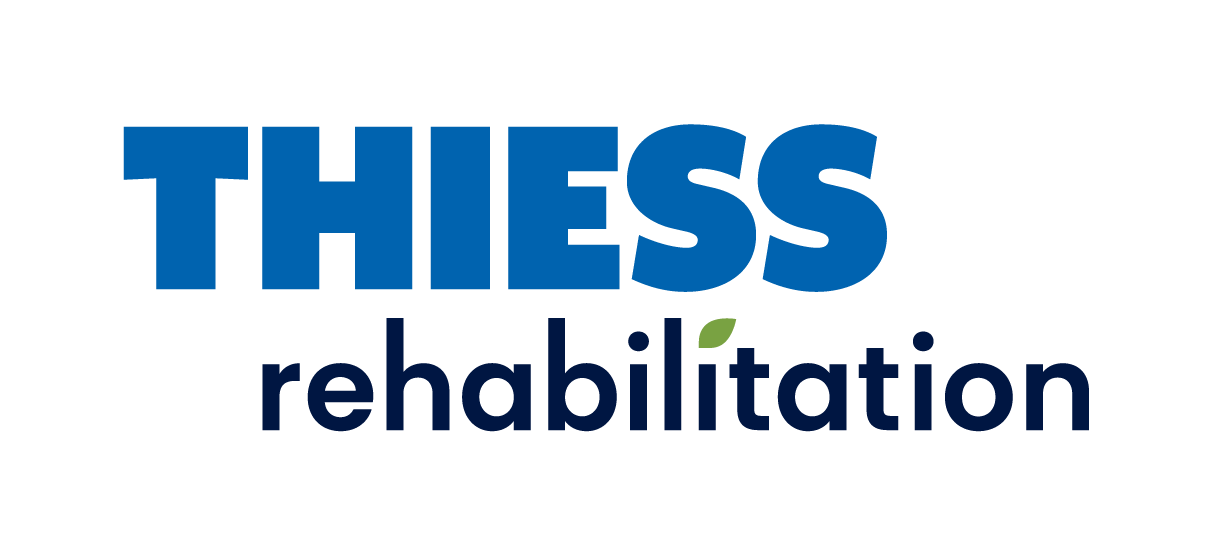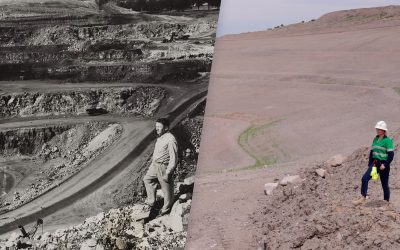Australian Mining sat down with our group manager, James Anderson, to discuss what happens at the end of a mine’s life, and how Thiess Rehabilitation works with our clients to return land to “an agreed state that is safe, stable and non-polluting”.
With permission, we’ve reproduced it here:
Mine rehabilitation is the treatment and management of disturbed land or water for the purpose of establishing a safe and stable environment.
Mining rehabilitation covers demolition of infrastructure, remediation of contaminated land, establishing a final landform, and revegetation. It can be carried out during mining operations or once operations have ceased.
Thiess Rehabilitation offers a full suite of mine rehabilitation services by miners who are also environmental experts. The Thiess Rehabilitation team provides technical and operational expertise backed by whole-of-mine-life knowledge. The company takes the responsibility of mine rehabilitation out their client’s hands, allowing them to devote their attention to mining.
Can you tell me a bit about Thiess Rehabilitation?
We’re a standalone rehabilitation business set up within Thiess. We offer an end-to-end rehabilitation service for mine sites, which covers planning and design through to the construction and monitoring and maintenance of mine rehabilitation.
Generally, we start off with the current, disturbed mine surface and the parameters that are client specified, legislated and stipulated in the environmental approvals for the site. What we do first, is look at the surface of the mined land and determine an effective, suitable and efficient final landform design. We then agree a design and reshape the mined land, incorporating drainage features as required, replace topsoil, and plant agreed upon species back to the rehabilitated surface.
We typically rehabilitate the sites back into grazing land or native ecosystems, in accordance with the required end land use.
How did Thiess Rehabilitation begin?
It was born out of a notion that the value in mining isn’t fully realised until – from a sustainability point of view – the land is returned to a sustainable state.
Thiess has delivered award-winning rehabilitation and industry-leading rehabilitation globally for more than 30 years. And the idea of launching Thiess Rehabilitation was to leverage all the good work we’ve done as a company into a standalone business, offering our services to clients without being connected to a mining services contract.
Thiess Rehabilitation means we can now offer mine rehabilitation as its own service.
What is mine rehabilitation and how has it changed over the years?
In very simple terms, it’s the restoration of mined and disturbed land. Rehabilitation is about returning the land to an agreed upon state that is safe, stable and non-polluting.
As for how it’s changed over the years, both legislative and stakeholder expectations around mine rehabilitation have increased over time, particularly in Australia, where the expectations on mine rehabilitation could be seen globally as the industry-leading standard.
A great example of that is we’re now mimicking natural landforms in land rehabilitation, so not just doing very standard or modular-type design, but actually incorporating more natural features into the rehabilitation.
Historically, the easiest way to profile mined land was to form a moderately graded slope and install some contour banks. But now we’re looking at how to incorporate the slopes and the dips into more natural designs that mirror the surrounding landforms.
Is there a rehabilitation project of which you’re particularly proud?
Some of the work that Thiess has done in the Hunter Valley (NSW) since the mid-90s has been industry-leading practice.
Working with our client at a particular site, we’ve been able to complete rehabilitation right up against a state forest in the area. That project actually kicked off in the mid-90s, and then rehabilitation kicked off a couple of years after that. It’s received a number of awards for the quality of the rehabilitation.
And now what we’re seeing is that the rehabilitated land is practically indistinguishable from the state forest which abuts up against the mine, so much so that native species are migrating from the state forest to the rehabilitated land.
Another great example is the work that we’ve done near Muswellbrook (NSW). We’ve been designing the rehabilitation alongside the mining process and mimicking a natural landform. The advantage of this is that we’ve been able to operate a mine in close proximity to Muswellbrook township.
And if you were to look out at the mine from Muswellbrook, you’d see a rehabilitated surface that blends in with the natural landforms of the area.
Doing rehabilitation well is something that really doesn’t cost much more than doing it minimally – if it costs more at all. It also can really add to our clients’ social licence to operate.

How does Thiess Rehabilitation help clients address their main problems?
Our clients are mining companies and their business is focused on mining – as it should be.
And what we’re doing with Thiess Rehabilitation is saying, we can take on the full mine rehabilitation lifecycle for you.
That way, our clients can focus on mining. They can apply their capital and their people to mining while we apply our equipment, our people, and our smarts in terms of delivering technology led, optimised rehabilitation solutions. We put in place a long-term, structured plan for how our clients can meet their rehabilitation commitments.
Our end-to-end capability is a powerful asset for our clients in the rehabilitation space because it allows them to focus on mining while we take care of the rest.
What’s the benefit of working with an organisation as large as Thiess?
It’s easily the access to all of the knowledge that we have available through Thiess.
Whether it’s the planning, advanced equipment strategies, safety performance, technology, we’ve got a lot of knowledge and expertise as a mining services brand and Thiess Rehabilitation has access to all of it.
What does the future hold for Thiess Rehabilitation?
There is increasing demands on mine operators around completing quality mine rehabilitation. Whether that be legislative commitments, whether it be stakeholder expectations, the focus on mine rehabilitation is certainly increasing.
What we want to do is create a value proposition for our clients where they can come to us and we can really provide a value added mine rehabilitation service. That way our clients can focus on their core business of mining.
We’re going to continue to develop as a business as the focus on mine rehabilitation grows. And not just in Australia, but in the other jurisdictions in which Thiess operates.
For more information about our mine rehabilitation services or opportunities to work with us, connect with our team.


